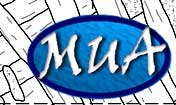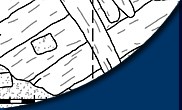
Excavations on EPII and Brick Wreck
23-27 June 2008
By Dean Nones and Team 2:
Ashley Marquardt, Brian Durnan, and Bryce Rodgers
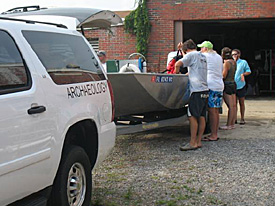
Students loading up vehicles and boats at MSC.
At the beginning of the week our team continued work on the south unit at Emanuel Point II. We dredged and recovered artifacts such as a part of an olive pit, bone, slag, resin, nut hull, and our unit's first piece of ceramic. The depth of the unit has posed some interesting challenges for the team, as we get deeper our workable space decreases and our unit’s walls become unstable. We are experimenting with different techniques for dredging such as removing our fins to keep a stable position while working with the dredge and doing "handstands" (dredging with one hand and holding the body straight up with the other) in the unit and to avoid putting pressure on the walls.
Tell someone you're diving off the coast of Florida and they will picture the clear warm waters of the Keys. For the crew of this years West Florida University field school it's a bit different. These photos were taken at the EPII wreck site.
Our team was split on Tuesday; Bryce and Brian continued work on the south unit while Ashley went to the Brick Wreck. Brian and Bryce tried using the flexible extender hose for the dredge since the unit is getting deep now and discovered a mystery feature. The wood elements of the new feature are oriented in a way contrary to the rest of the ship's layout. At this time we have no idea what it is or why this feature is located at this position in the unit. Meanwhile our third team member, Ashley, was exploring the Brick Wreck.
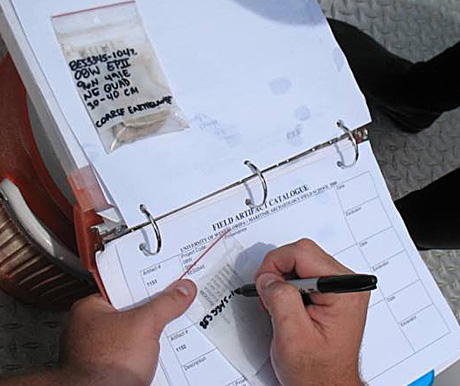
Student filling out artifact tag and field catalogue.
The Brick Wreck is a 19th century vessel that appears to have been a cargo carrying vessel of some type. The vessel sank with a full cargo of brick, hence the name of the site. It is located in Pensacola Bay, only a short distance away from the EPII site, in 13ft. of water. It was first discovered in Feb. 2007 by a team of UWF grad students that were conducting target dives in Pensacola Bay to locate culturally significant sites. The initial discovery consisted of a submerged pile of brick that was marked for later investigation. The site was briefly investigated again during the summer 2007 field school. Students felt what appeared to be a wooden structure that seemed to indicate that the site was shipwreck. From Jan. 2008-May 2008 the site was excavated by teams of both graduate and undergraduate students. Three test excavation units were set up on site: one 2m X 2m unit, and two 1m X 1m units. After excavation of the test units, it was determined that the 2m X 2m unit was established on a 2m X 2m hatch, while the two 1m X 1m units were established at the eastern extent of the site. Excavation of these two units produced the hull of the vessel which appears to be a double hull that slopes inward and curves through one of the 1m X 1m units. Artifacts have also been recovered from the site. Artifacts include several bricks recovered from the hatch, square fasteners, an intact spike, and several large concretions that may have been part of the vessel's rigging indicating that it may have been a sailing vessel. The bricks appear to be augured (wire-cut), locally produced, and were of a type used for houses. Work this summer will be centered on continuing test excavations of the site in order to determine the type of vessel it was as well as attempt to determine where the bricks were manufactured.
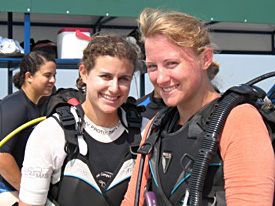
Bryce and Ashley on the UWF Barge.
The Brick Wreck is a zero visibility environment that tests the diver's comfort level. It is a great opportunity to train students for future challenges. A diver exploring the Brick Wreck has to become familiar with the murky visibility and soft unstable bottom that will sink under the pressure of a diver and can engulf the diver. The diver becomes less reliant on his or her eyes as they use their sense of touch to learn about the wreck. The experience is thrilling for some and unsettling for others.
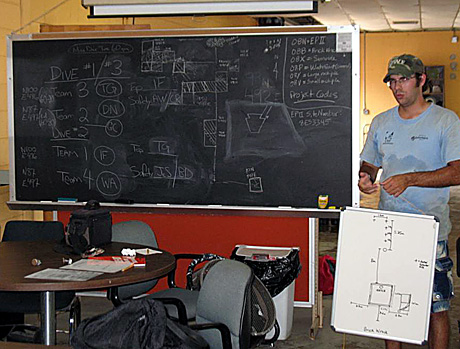
Dean briefing students on the Brick Wreck.
On Wednesday we began our new excavation rotation. The added depth in our unit makes it difficult for more than one person to fit in to dredge so we have begun excavating with one person in the unit, while the other holds the extender hose in place. Since the third person is unable to fit into the unit to help, we have decided to rotate positions every 15 minutes, so that each person gets to participate in every aspect of the excavation. This week the north and south unit teams started finding more artifacts. Several concretions were found in the north unit and one was found in the south unit, along with pot shards and other organic materials. On Wednesday and Thursday, while Brian and Ashley were diving on EPII, their third team member Bryce was at the Brick Wreck. Diving on the Brick Wreck was cancelled on Wednesday before the last team could get in the water, so Bryce went back again on Thursday to experience diving on the low visibility site. Visibility for the Brick Wreck on Thursday was phenomenal until the bottom muck was agitated, then the murky, unfamiliar environment became a little unsettling. On both Wednesday and Thursday diving time was forced to be cut short due to dangerous weather conditions. We had to quickly pull divers out of the water and head for land on both days because of large unpredictable storm systems.
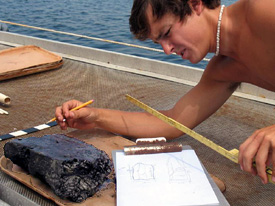
Chris recording part of a timber from EPII.
On Friday, due to the presence of rather large ominous clouds early in the morning, diving was cancelled for the day and all teams moved over to the conservation lab for orientation and lab work. As soon as orientation was over, the dive teams split up, with some heading back to Marine Services to perform our regular Friday clean up and other miscellaneous chores that needed to be completed, while other teams stayed at the conservation lab to process artifacts. Our team was one of the teams that stayed in the lab. We filled out paperwork, weighed, measured, drew, photographed and changed the water for some of the artifacts that have been collected from the site in the first few weeks of excavation this summer. The amount of documentation prior to conservation on just one small piece of ceramic is extensive! Once this work was completed, we moved back to Marine Services to help the other teams with the rest of the clean-up.
Please feel free to contact us if you have any questions or concerns at: mua@keimaps.com.
Return to Project Journal home page.
